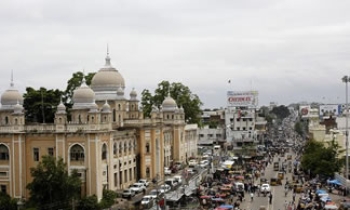The print media in India is a long way from being dead if the official report on the state of the print publications is anything to go by. The Press in India 2004-5, the annual report of the Registrar of Newspapers for India (RNI), says the print media claimed a substantial share in the information space in the country registering 1,948 new newspapers and over a two crore increase in circulation in 2004-05.

According to official records, four newspapers also ceased publication during 2004-05. As on March 31, 2005, there were 60,413 registered newspapers on record as against 58,469 at the end of March 2004. The total circulation of newspapers increased from 13,30,87,588 copies in 2003-04 to 15,67,19,209 copies in 2004-05. The number of newspapers submitting annual statements also increased to 7,225 from 5,591.
Publishers under Section 19D of the Press and Registration of Books (PRB) Act, 1867, are required to submit annual statements to the Registrar of Newspapers for India. These annual statements are the principal source of data for compilation of this annual report. Needles to say, all publishers do not submit their annual statements.
Hence, this report cannot be treated as comprehensive, the preface to the study noted, and cautioned that it can give only a broad overview on the general trend of the Indian press based on the number and circulation of the newspapers. Since the data is based on the number of annual statements for the year 2004-05, these can only be termed as claimed circulation figures.
As per the annual statements, the number of dailies being published in the country was 1,834. Their claimed circulation figure was 7,86,89,266 copies, 7 per cent higher than in the previous year. Hindi had 799 dailies claiming a circulation of 3,37,73,557 copies, while 181 English dailies sold 1,07,71,169 copies. There were 40 tri/biweeklies with a circulation of 5,53,873, compared to 11,76,705 in 2003-04. In all, 931 dailies newspapers provided information on their working and organisation.

The majority of Indian newspapers were periodicals. Circulation details were available from 5,351 periodicals which totaled 7,74,76,070 copies. Out of these, 2,627 were weeklies, 824 fortnightlies, 1,407 monthlies, 239 quarterlies, 44 annuals and 210 of other periodicities.
Circulation of periodicals increased from 5,83,73,701 copies during 2003-04 to 7,74,76,070 in 2004-05. Weeklies led with 4,21,63,994 copies, followed by monthlies (2,02,31,088), fortnightlies (1,03,31,047), other periodicals (21,96,923), quarterlies (16,16,060) and annuals (9,36,958).
Newspapers were registered in English and 22 main languages listed in the Eighth Schedule of the Constitution. Newspapers were also registered in 100 other languages including dialects and a few foreign languages. The highest numbers of newspapers were published in Hindi (3,265), followed by English (873), Bangla (492), Gujarati (477), Urdu (403) and Marathi (329).
In terms of circulation, Hindi newspapers continued to lead with 6,70,35,756 copies, followed by English with 2,72,90,601. Gujarati with 83,52,093 came third. Urdu and Malayalam followed closely with 81,09,935 and 76,91,166 copies respectively.
Among language dailies, Hindi led with 799 newspapers followed by 181 in English. The languages that published more than 100 daily newspapers were Marathi (127), Urdu (162) and Telugu (110). Circulation-wise, the Hindi press maintained its dominance with 3,37,73,557 copies followed by English with 1,07,71,169.

During 2004-05, the largest numbers of newspapers were published from Uttar Pradesh (1,385), followed by Delhi (,1029), Maharashtra (646), Rajasthan (598) and West Bengal (559). In the previous years, Uttar Pradesh topped in total circulation, but in 2004-05, Delhi sped ahead with a circulation of 2,65,01,569 copies, leaving UP behind with 2,62,85,541 copies. Maharashtra retained its third position with 1,59,59,124 copies.
Uttar Pradesh had the largest number of daily newspapers (285), followed by Maharashtra (197). Daily newspapers are published from all the states. However, no circulation details were made available from the union territories of Andaman & Nicobar Islands, Dadra & Nagar Haveli, and Lakshadweep. Dailies from Uttar Pradesh with a total circulation of 1,11,45,976 copies were at the top, followed by Maharashtra with 83,46,863 and Delhi 80,79,842 copies respectively.
A notable feature was that Orissa achieved the distinction of publishing newspapers in 17 major languages (bilingual and multilingual publications have not been included in the 17 major languages). Delhi came next with 13, Maharashtra 12, Kerala 9 and Karnataka 8. Uttar Pradesh published the maximum number of newspapers in a single language i.e., 1,155 in Hindi.
Other states with notable number of language newspapers were Rajasthan 545 in Hindi, Delhi 492 in Hindi, Gujarat 439 in Gujarati, West Bengal 430 in Bangla, Madhya Pradesh 422 in Hindi and Maharashtra 309 in Marathi. It was also noticed that regional language newspapers were leading both in number and circulation in all major states. These details exclude bilingual and multilingual publications since these are not individual languages.

Out of the 7,225 newspapers that submitted their annual statements, 323 were ‘big’, 1369 ‘medium’ and 5533 were ‘small’. The ‘big’ ones circulated 6,02,91,789 copies, the ‘medium’ 5,68,46,893 copies, and ‘small’ 3,95,80,527 copies. In the ‘big’ category were 198 dailies and tri/bi-weeklies. In the ‘medium’ category the number stood at 830, and in ‘small’ 846 dailies. Their circulation accounted for 3,39,78,571 copies, 3,53,70,484 copies and 98,94,084 copies respectively.
Hindustan Times, published from Delhi and printed at New Delhi, Gurgaon, Noida, Chandigarh, Bhopal and Jaipur, was the largest circulated single edition daily with 11,75,339 copies followed by Ananda Bazar Patrika, published from Kolkata with 11,30,167 copies. The Times of India, published from New Delhi and printed at New Delhi and Sahibabad came third with 11,02,772 copies.
The Times of India, having eight editions with a combined circulation of 27,71,669 copies came first among multi-edition dailies. Dainik Jagran in Hindi having 15 editions, claiming a combined circulation of 24,83,432 copies stood second. Dainik Bhaskar (Hindi) with 16 editions and a combined circulation of 19,01,384 copies, occupied the third position.
Among periodicals Rishi Prasad, a Hindi monthly from Gandhinagar topped with a circulation of 11,37,050 copies, while Saras Salil, a Hindi fortnightly, published from Delhi came second with a circulation of 10,53,119 copies.
Out of 7,225 newspapers, as many as 5,680 were owned by individuals, 973 by joint stock companies, 157 by trusts, 134 by societies and associations, and 169 by firms and partnerships. In all, 64 newspapers were brought out by the central and state Governments. Cooperative societies, educational institutions and the like owned the remaining 49.

Newspapers owned by individuals had the largest share in circulation — 53.10 per cent, followed by those owned by joint stock companies 37.38 per cent. In all, 307 common ownership units brought out 1,174 newspapers during the year. These units also published 101 papers, which had no news content. Newspapers, belonging to these units, had a circulation of 6,26,90,430 copies, i.e. 37.26 per cent of the total circulation of the Indian press. Dailies published by these units had a circulation of 4,59,59,067 copies i.e. 58.26 per cent of the total circulation of daily newspapers.
Out of the total 5,351 periodicals, 4,645 dealt with news and current affairs, while 63 were dealing with religion and philosophy. Apart from these there were other periodicals, dealing with various subjects, such as social welfare, medicine and health, education, finance and economics, literature and culture, children, women, law and public administration, cinema, commerce, agriculture and animal husbandry, science, sports, engineering and technology, and industry, etc.
There were 64 government publications — 56 central and eight state. Employment News, an English weekly published from Delhi was the largest circulated government publication with a figure of 5,47,486 copies.
Apart from general newspapers and specialised journals, there were 3,724 registered publications, without a definite periodicity. These publications werre, therefore, not included in the study. Of the 3,724 miscellaneous publications only 29 furnished their circulation data, claiming 81,41,877 copies.
Twenty-eight foreign missions in India had 111 registered publications. Majority of these were registered from Delhi and others from metropolitan cities of Mumbai, Kolkata and Chennai.









